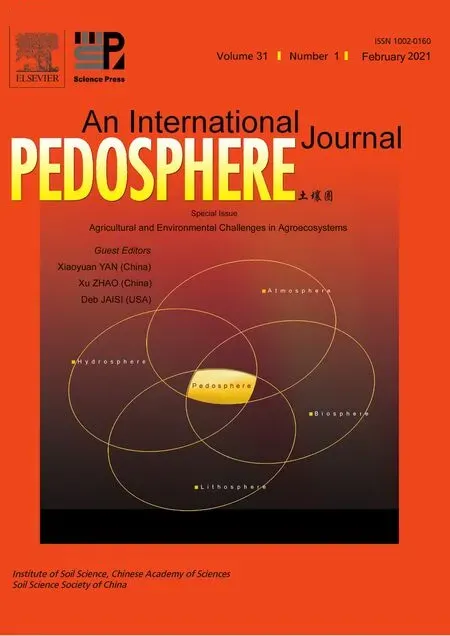Notes to Authors
2021-11-28
All manuscripts should be submitted electronicallyviaPEDOSPHERE Online Editorial System(POES),the web-based online manuscript submission,tracking,peer-review and editorial management system of PEDOSPHERE,at http://pedosphere.issas.ac.cn,where a detailed information for contributors to PEDOSPHERE is available.Please consult carefully the style and layout of the latest issues of PEDOSPHERE and pay special attention to the following notes:
General
PEDOSPHERE is a peer-reviewed international periodical.PEDOSPHERE welcomes submissions from scientists around the world under a broad scope of topics relevant to timely,high quality original research findings,especially up-to-date achievements and advances in the entire field of soil science studies.It publishes mainly full-length research papers as well as reviews,short communications,letters to the Editor and special issues.Contributions must be written in English and should have been neither published nor submitted for publication elsewhere.All articles will undergo double-blind peer review prior to acceptance.The Editorial Committee reserves the right to make the final decision on the acceptance or rejection of the contribution.
The Editors encourage brevity.A full-length research paper is generally limited to 8 printed pages,a review paper should not exceed 14 printed pages,and a short communication and a letter to the Editor must not exceed 4 printed pages,including figures,tables and references.The total number of illustrations and tables should not exceed seven.
Questions and suggestions on PEDOSPHERE may be directed to the Editorial Office of PEDOSPHERE,Institute of Soil Science,Chinese Academy of Sciences,P.O.Box 821,Nanjing 210008,People’s Republic of China.Tel.:+86-25-8688 1235,Fax:+86-25-8688 1256;E-mail:pedosphere@issas.ac.cn,pedospheradm@issas.ac.cn.
Preparation of manuscripts
Manuscripts should be prepared using Microsoft Word.Manuscript pages must be numbered consecutively.
The International System of Units(SI)should be used for all the data as far as possible,but the abandoned units such as˚A,bar,mmHg and Cal are not acceptable,and the following units are not permitted:
% for plant nutrient or chemical element concentration—use mmol kg−1or g kg−1;
% for water content—use g kg−1;
ppm for mass or volume—use mg kg−1or mg L−1;
meq for exchange capacity—use moles of charge per unit mass(cmolckg−1);
NorMfor substance concentration—use mol L−1.
Abbreviations should be used sparingly and must be defined at first mention in the text,abstract,and each table and figure and used consistently thereafter.
Nomenclature:The Latin binomial or trinomial(in italics)and authority must be included with the common name for all plants,insects,animals and microorganisms at first mention in the abstract and the text.For soil nomenclature,an international classification system(e.g.,FAO-UNESCO system or USDA Soil Taxonomy)may be included as reference,when a local classification is presented.
Tables and Illustrationsshould be numbered according to their sequence in the text.Tables should not duplicate the results of the text and figures.Authors should ensure that the data in the tables are consistent with those cited in the relevant places in the text,and data have been calculated correctly.Illustrations should be limited to the number necessary for clarity and must not duplicate data given in tables or in the text.All illustrations should be arranged at the end of the manuscript,and their preferred positions should be indicated in the text.Photographs,charts and diagrams are all to be referred to as“Figure(abbreviated to‘Fig.’)”.Each figure should have a caption.
Footnotesshould be avoided,except to identify the corresponding author.
Referencesshould include all published works referred to in the text and arranged alphabetically by author without serial numbering.The author-year system is used in the text.The reference list must not contain unpublished observations,personal communications,personal correspondences,unarchived materials obtained from the World Wide Web,etc.“Anonymous”is not acceptable as an author.The publications in languages with non-Latin alphabets should be translated into English,and for the publications in languages other than English a notation such as“(in German)”,“(in Japanese)”,“(in Chinese)”and“(in Russian)”must be added behind the name of the periodical,proceedings or book.Examples of reference citation are as follows:
For journals:Sato E,Toyota K.2006.Application of PCR-DGGE into community structure analysis of soil nematodes.Jpn J Soil Sci Plant Nutr(in Japanese).77:157-163.
For books:Van Meurs A P H.1971.Petroleum Economics and Offshore Mining Legislation.Elsevier,Amsterdam.
For chapter references from books and symposium proceedings:Chen J F,He Q.1985.Chemical distribution of oxide
mineral in soil colloid.InHseung Yet al.(eds.)Methods for Soil Colloid Research(in Chinese).1st Edn.Science Press,Beijing.pp.241-303.
For dissertations:Cairn R B.1964.Infrared spectroscopic studies of solid oxygen.Ph.D.Dissertation,Beijing University.For web references:Ohio Department of Development.1997.Ohio county profiles:Tuscarawas county.Available online at
http://www.odod.ohio.gov/osr/profiles/pdf/tuscaraw.pdf(verified on June 12,2003).
Submissions not conforming to the above guidelines may be returned to the authors.Failure to return the manuscript revised strictly following the editor’s requirements in time will significantly delay processing of the manuscript.If not returned within 2 months,the manuscript will be released,and it must then be resubmitted as a new paper.
杂志排行
Pedosphere的其它文章
- Agricultural and environmental challenges in agroecosystems
- In Commemoration of Professor Tianren YU’s 100th Anniversary
- Microbial diversity assembled from series-diluted suspensions of diseasesuppressive soil determines pathogen invasion resistance
- Global patterns of phosphorus transformation in relation to latitude,temperature and precipitation
- Chemical and spectroscopic characteristics of humic acid from a clay loam soil in Ontario after 52 years of consistent fertilization and crop rotation
- Interactive effects of elevated CO2 and nitrogen fertilization levels on photosynthesized carbon allocation in a temperate spring wheat and soil system
